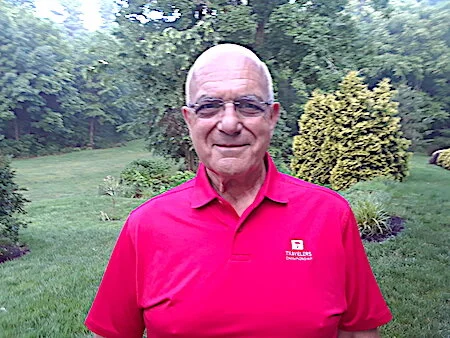FROM THE TRAVELERS: Think twice about how Mackenzie Hughes’ shot info got to you so quickly
CROMWELL, Conn., June 26 — After a sensational first-round 60, Canadian Mackenzie Hughes takes a three-shot lead into the second round at The Travelers Championship today. Those watching Golf Channel’s coverage saw Hughes and the field make their way around TPC River Highlands with many low scores. What home viewers are educated about—even more important this year since spectators are not allowed on the course—is exposure to the usual details regarding player strategy, shot yardages and club selection. But such insider information hasn’t been the norm for very long.
“Back in the day”—a phrase that means more to me with every passing year!—watching tournament golf on TV was a rudimentary exercise. When a player was shown during a round, viewers were told the hole number, par and yardage. If the player was hitting a tee shot, we would assume driver was in hand. After the strike, if the cameraman was on his game, we saw where the ball finished. But it wasn’t a guarantee.
John Carbone: Works the Travelers to make sure ShotLink data gets from the course to the TV viewer and beyond.
From there, it was a crapshoot. Shots to the green were a mystery. Viewers rarely knew a player’s yardage or club selection. Things started to change when roving reporters followed the lead players, and with the help of caddies were tipped off to club choice, which they relayed to viewers. More hustle by the reporter and TV staff helped provide tee-shot length and approach yardages to give viewers more info.
The PGA Tour itself got into the statistical realm with playing stats in 1980. It first put electronic scoreboards on the course in 1983, with 19 scattered around the course at each tournament. The system went wireless in 1987 to collect data. In the early 1990s, the system went from a simple scoreboard to a complete scoring system so that 60 locations such as media and hospitality could search the databases if needed. Then in 1999 an analysis of the present system was done to see what the future held and from that came the system known as ShotLink, which would help eliminate errors and improve accuracy. The system was powered by CDW’s sophisticated technology.
The field in The Travelers this week, as happens at every tour stop, will be playing a course, TPC River Highlands, that has been mapped out so that each hole is in digital form. Using coordinates such as the location of the hole along with the location of the player and his ball, distances are calculated. This system is used to keep player stats as well as giving TV watchers insight into how a golfer is playing the hole.
Each week, the PGA Tour’s modest-sized staff works in coordination with the local volunteers, who can number around 350 on a normal week. For the entire tour season, the ShotLink volunteers total around 10,000.
One of those volunteers who has been at The Travelers is John Carbone, who I have come to know through membership in the Shoreline Golf Society. This is John’s 18th year as a volunteer at the Hartford tour stop and recently he’s been working on the ShotLink side. What follows is John’s own blog about the laser-scoring process as he’s experienced it at The Travelers:
“Since 2004, the PGA has incorporated ShotLink digital scoring from tee to green. Fairway yardages are measured with a laser gun in the fairway (one on a par 4 and two on par 5s). Greenside lasers are located in towers behind each green with a surveyor tripod laser for recording player shots to the green and all putts into the hole.
“The accuracy of the lasers is plus or minus one yard for fairway shots and plus/minus 0.25 inches on the green. In 2016, the PGA ran beta tests on a new technology for replacing the greenside lasers. It incorporates three digital cameras around the green with a laptop for recording/sending the data. In order to be used at the PGA tournaments, the accuracy of the information must be at 95 percent.
“In 2018, The Travelers Championship used the new systems, which continues to send the data instantaneously to the scoring trailer. Even with the new process, human scorers are still needed for judgment when a ball is outside the green area. Although viewers can appreciate the instant information for each golfer, each PGA Tour professional has access to his round(s) for analysis, on the same day of his round. Note: This change eliminates all scoring towers; assembly and disassembly; storage and transporting; man-hours of labor. It is very cost effective.”
The regular tour, Champions Tour and Web.com Tour all operate the ShotLink system, around 90-plus events during a normal season. The tour has written in its media guide that ShotLink is used by “On-site television broadcast partners (GOLF Channel, CBS , NBC); over 2,500 executions per year hit the air due to ShotLink that would not otherwise be possible; International Broadcast partners; pgatour.com; studio shows (Golf Central, Inside the PGA TOUR, etc.); players, coaches and caddies; print media; mobile devices (available on pgatour.com); on-site partners providing fan enhancements including video boards, kiosks and multi-media solutions; more than 50 additional clients of the PGA Tour, and golf course architects who review ShotLink data when evaluating course changes.”
So enjoy the final three rounds of The Travelers and think about how the shot data that was just passed to you was calculated, with volunteers such as John Carbone, so you can feel like you’re in a player and caddie’s inner circle, and this year in particular, feel like you’re right there on the course.

